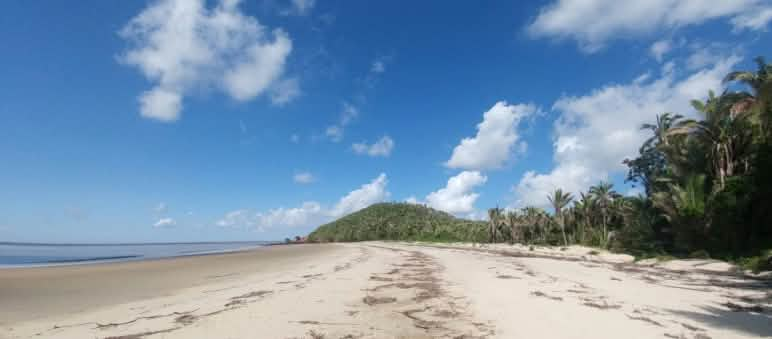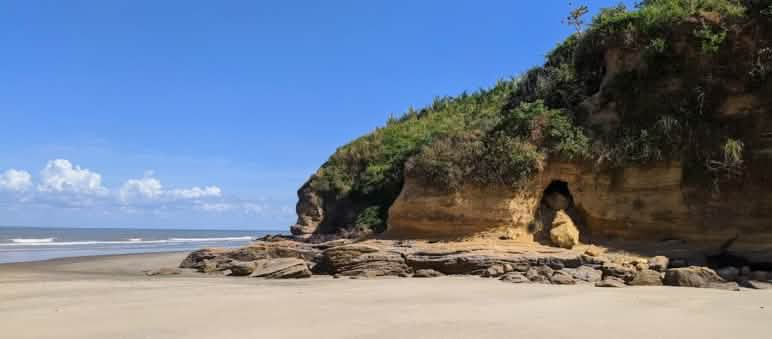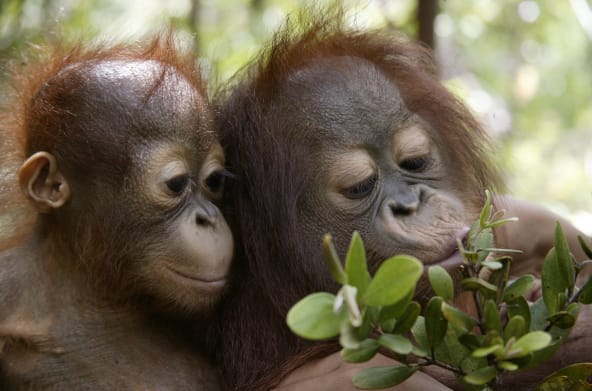Brazil: Rail and port construction with German involvement threatens people and nature
In Brazil, a billion-euro project to build a private freight railway and a port to export raw materials to Europe and China threatens the Amazon rainforest, the Cerrado savanna and local communities. Deutsche Bahn is already involved, and Germany's KfW development bank and GIZ development organization are exploring possible support for the project.
In the bay of São Marcos on the Atlantic Ocean in Brazil lies an almost untouched tropical paradise: The island of Cajual, located in the state of Maranhão in the northeast of the South American country features kilometers of white beaches, palm and mangrove forests, and extensive wetlands.
150,000 migratory birds stop in the bay each year, which is part of two state and international RAMSAR protected areas. Cajual is an important breeding ground for the magnificent scarlet ibis (Eudocimus ruber), which is listed as endangered in Brazil. Thousands of other species such as sea otters, manatees and dolphins live in the diverse marine and terrestrial ecosystems.
The rocky coast in the east of the island is home to the important archaeological site of Laje do Coringa, which is rich in fossils from the mid-Cretaceous period some 95 million years ago, including dinosaurs, crocodiles, turtles, fish and tree ferns.
Cajual is home to the Quilombolas, descendants of enslaved Africans who arrived in the region at the end of the 19th century after the abolition of slavery. They practice traditional agriculture and fishing and have preserved the island's natural environment thanks to their environmentally friendly way of life.
Railway and export port for raw materials and energy
But that could soon change: Under the plans of three Portuguese businessmen, people and nature are to make way for the Grão-Pará Maranhão (GPM), a major private infrastructure project consisting of the Terminal Portuário de Alcântara (TPA) export port and an associated 520-kilometer freight railway, the Estrada de Ferro do Maranhão (EF-317).
The railway will connect the port with the hinterland of Maranhao and the states of Pará, Tocantins, Mato Grosso, Piauí and Bahia, allowing hundreds of millions of tons of locally grown and mined raw materials to be shipped to Germany, the EU and China. Terminals will be built for agricultural commodities such as soy, mining products such as iron ore and bauxite (aluminum ore), crude oil, liquefied natural gas (LNG), fertilizers and shipping containers.
A third project is planned for the production and export of "green hydrogen" and ammonia (Green Energy Hub - H2A). This will involve the construction of hydrogen (electrolysis) and ammonia plants, as well as wind and solar farms to generate the "green energy" needed.
The island, located 20 kilometers from the capital city of São Luís on the western side of São Marcos Bay, is completely undeveloped. As a result, in addition to ship docks, loading facilities and raw material terminals, the project will require the construction of roads, bridges, high-voltage and communication lines, wastewater treatment plants and the like. In order for cargo ships of the latest and largest Valemax class (with a capacity of about 400,000 tons and a length of 362 m) to enter the port, the coast will have to be dredged to a depth of more than 25 m.
As far as is known, the operators have not submitted any environmental impact or social studies for the projects, but have already received 99-year construction and operation permits for the rail project from the Brazilian government. The operators estimate the cost of the project at around 20 billion real (currently equivalent to 3.5 billion euros).
Partnership with Deutsche Bahn AG
Deutsche Bahn AG (DB), which is wholly owned by the German government, has already agreed to participate in the project with the operating consortium. DB states that "the DB E.C.O. Group has signed a Memorandum of Understanding (MoU) with Grão-Pará Maranhão (GPM) for the joint project development and subsequent operation of the railway", with "DB assuming the role of shadow operator".
The state-owned German development bank, Kreditanstalt für Wiederaufbau (KfW), as well as the state-owned Gesellschaft für Internationale Zusammenarbeit (GIZ) development organization, "are already looking into how they can support the project," writes Saskia Berling, Director of KfW Brazil.
German government promotes the project
At the invitation of the German Ambassador to Brazil, Heiko Thoms, Berling joined Brazilian politicians, EU officials and executives from Siemens and other companies at a presentation of the project at the German embassy in Brasilia at the end of January, where DB unveiled its partnership with the operator consortium.
According to reports in the Brazilian media, the German embassy requested information about the project and instructed German Chancellor Olaf Scholz to raise the issue with President Lula da Silva during his state visit to Brazil at the end of January. The German embassy, to which Rainforest Rescue has written, denies this.
"The advantages of the rail and port project lie in the care taken with social and environmental issues, as well as in the opportunities offered by the proximity to Europe for the development of the energy sector," Peter Mirow, Head of DB in Brazil, told Agência INFRA. This is likely to involve liquefied natural gas from planned fracking projects in the interior of Maranhao and crude oil to be pumped from the deep sea off the Brazilian coast.
The project operators are said to have held talks with Siemens as a potential partner for the construction of an export hub for renewable energies and "green hydrogen". The German Federal Ministry for Economic Cooperation and Development (BMZ), through the GIZ, is already financing the expansion of "green hydrogen" production in Brazil for local consumption and export. To this end, a German-Brazilian alliance for “green hydrogen” has been established.
Threats to the Amazon rainforest and Cerrado savanna
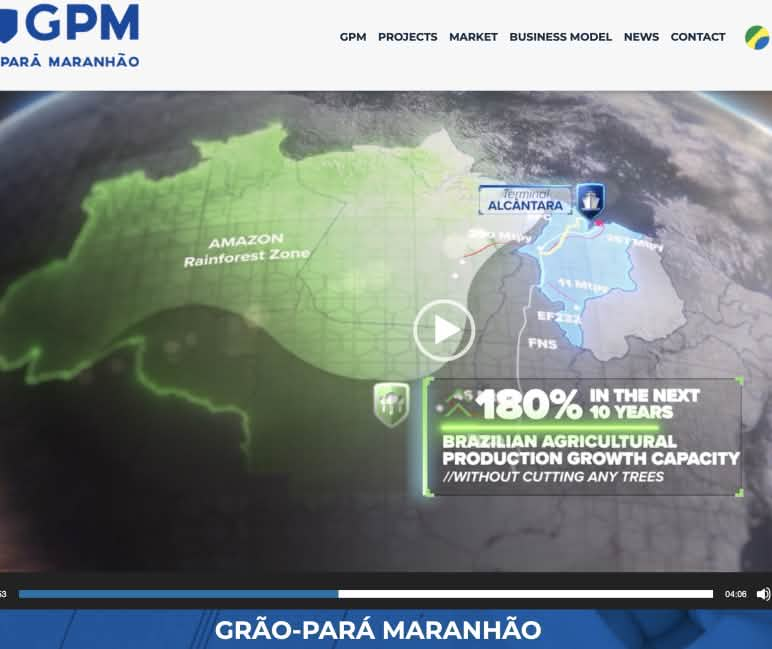
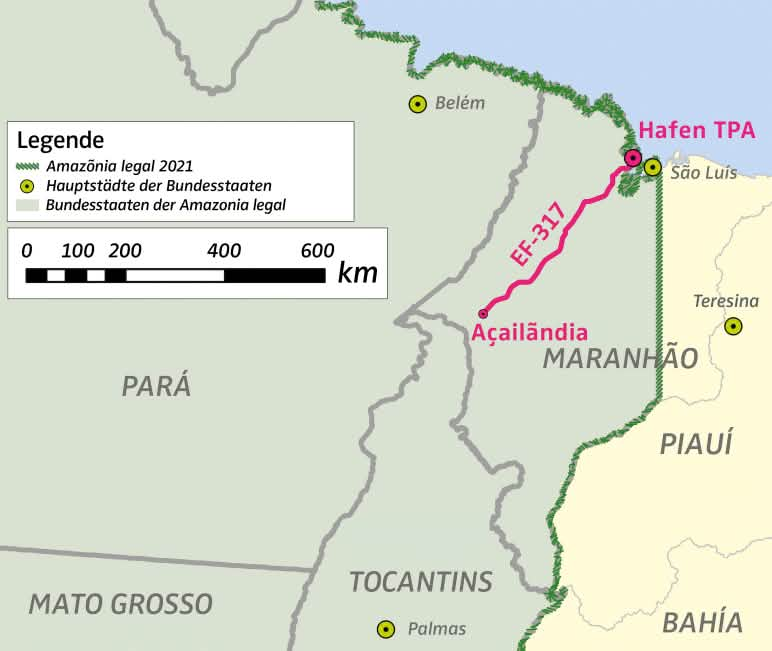
In a video presentation embedded on the DB website, with its logo at the end, the Amazon rainforest is shifted to the west, giving the impression that the port and the railway are outside the Amazon region. The graphic also states that "Brazilian agricultural production will increase by 180 percent in the next ten years without cutting down a single tree".
But the graphic and the information provided by the project operators are deceptive. The fact is that the location and boundaries of the Amazon region are officially and precisely defined in Brazil as the legal Amazon region (Amazônia legal). Both the port and the entire railway line are clearly within the legal Amazon, as our map with data from the Brazilian Institute of Geography and Statistics (IBGE) shows.
In addition, the port and the rail route are located directly in two state nature reserves, which are also international RAMSAR wetlands and Important Bird Areas (IBA). On its way to Açailândia, the 520-kilometer railway will pass through several federally recognized Indigenous reserves, home to at least seven different Indigenous peoples and numerous endangered species, as well as the Reserva Biológica do Gurupi.
Agricultural and mining boom
From its starting point in Açailândia, the railway will connect to existing freight railways that extend to the Amazonian states of Pará, Tocantins and Mato Grosso, as well as to the Cerrado savannas in the states of Piaui and Bahia.
According to DB, the planned logistics solution will create a new transport corridor for agricultural products, for which a potential demand in the hinterland of 80 million tons per year has been identified. In addition, there would be high demand for transportation services for mineral raw materials. According to the operators, iron ore exports through the port of TPA are expected to reach 200 million tons per year by 2030.
The increase in production and exports will inevitably mean the expansion of agriculture – especially for the cultivation of soy, sugar cane (including for ethanol), corn and cattle for meat production – and the expansion of mining at the expense of the Amazon rainforest and the Cerrado savanna. These activities are the main drivers of deforestation in Brazil.
Land conflicts, violence and violations of the law
The project also poses a major threat to the communities living in the areas, which mainly consists of smallholders, Indigenous people and Quilombolas. They cultivate the land using traditional, environmentally friendly methods, mainly for subsistence agriculture. The expansion of industrial agriculture and mining for export will therefore inevitably lead to countless serious land conflicts.
The Amazon region already has one of the world's highest rates of violence related to environmental and land conflicts. People are being robbed of their ancestral lands, threatened, beaten, displaced, kidnapped and murdered by the militias of soy, oil palm and cattle ranchers, timber and mining companies, police and politicians.
There are also unanswered questions about how the project operators and Deutsche Bahn intend to respect the rights of the Quilombolas living on the island of Cajual and along the railway line, who are recognized as traditional peoples under the Brazilian constitution, writes the Brazilian Cooperation Network (KoBra). Both Brazil and Germany have pledged to protect the rights of Indigenous peoples by signing the International Labour Organization (ILO) Convention 169.
Safety on Vale's existing Carajas iron ore railway
The private Estrada de Ferro Carajás (EFC) railway, owned by mining company Vale and used to transport iron ore from open-cast mines in the state of Pará to the export port of São Luís, is a good example of how the rights and safety of people living along existing railway lines in the region are affected. The nearly 900-kilometer line passes through 27 cities and more than a hundred towns, but has few rail crossings and safety precautions. The organization Justiça nos Trilhos has been monitoring and denouncing human rights violations for years.
It is particularly dangerous when the three-kilometer-long trains, consisting of up to 330 cars, stop for long periods of time and people then crawl under the freight cars to get to the other side. According to press reports, 47 people have died in rail accidents along the iron ore corridor since 2004. More than 100 people have been injured.
Our demand
Rainforest Rescue calls on the German government, KfW, GIZ and Deutsche Bahn not to participate in this project, as it is associated with very negative impacts on nature, the Amazon region, the Cerrado savanna and the people living there. The project is also incompatible with international efforts to protect and conserve the Amazon rainforest and the Cerrado savanna.
Rodrigues, A.A. 1995. Ocorrênciada reprodução de Eudocimus ruber na ilha do Cajual, Maranhão, Brasil: http://www.revbrasilornitol.com.br/BJO/article/download/0314/pdf_63
RAMSAR 2020. Brazil - Baixada Maranhense Environmental Protection Area:https://rsis.ramsar.org/RISapp/files/RISrep/BR1020RIS_2002_en.pdf
- de Carvalho Marchesini Santos, M.E. 2009. Paleontologia das Bacias do Parnaíba, Grajaú e São Luís: http://cprm.gov.br/publique/media/paleo/pale_cap15.pdf
- EmersonFerreiraTV 2012. Ilha do Cajual: https://www.youtube.com/watch?v=EnGmZhjn7hY
Da Silva Maia, M.R.; Pires Miranda, A.C. 2007. ILHA DO CAJUAL: conflitos e mecanismos utilizados na luta pela terra: http://www.joinpp.ufma.br/jornadas/joinppIII/html/Trabalhos/EixoTematicoI/eIXO%209%20170bf64a000e1a06af01Maiana%20Maia_Ana%20Caroline%20Miranda.pdf
- Paulo Alexandre Correia de Oliveira Salvador ("Paulo Salvador"), Executive director of Grão-Pará Maranhão: https://www.linkedin.com/feed/update/urn:li:activity:7024369681415254016/
- Nuno Gustavo da Silva Ribeira Martins ("Nuno Martins"), Executive director of Grão-Pará Maranhão: https://www.linkedin.com/in/nuno-gustavo-martins-55a8ab4b/
- Nuno Miguel da Mota e Silva ("Nuno Silva"): https://www.linkedin.com/in/nuno-mota-silva-4ab68238/
Website of the project operator Grão-Pará Maranhão: https://graoparamaranhao.com/en/gpm-learnaboutus/
The company name Grão-Pará Maranhã is apparently an allusion to the Portuguese colonial period, during which the state of Grão-Pará e Maranhão was proclaimed in northwestern Brazil in 1751 (see https://pt.wikipedia.org/wiki/E stado_do_Gr%C3%A3o-Par%C3%A1_e_Maranh%C3%A3o)
See https://graoparamaranhao.com/en/projects/hub-green-energy/
Agencia Infra 2023. Estatal ferroviária alemã faz acordo para desenvolver ferrovia privada no Maranhão: https://www.agenciainfra.com/blog/estatal-ferroviaria-alema-faz-acordo-para-desenvolver-ferrovia-privada-no-maranhao/amp/
DB E.C.O. Group 2023. Brasiliens multimodale Logistiklösung für nachhaltige Versorgungsketten: https://db-eco.com/de/brasiliens-multimodale-logistiklosung-fur-nachhaltige-versorgungsketten/
Post by Saskia Berling, Director Brazil - KfW Development Bank on Linkedin on 24.1.2023: https://www.linkedin.com/in/saskia-berling-616586a2/
Ministério da Integração e do Desenvolvimento Regional (MIDR) 2023. Conheça o Projeto Grão Pará Maranhão: https://www.youtube.com/watch?v=-kLef29gIhg
O Informante 2023. Estatal ferroviária alemã faz acordo para desenvolver ferrovia privada no Maranhão: https://oinformante.blog.br/notas/estatal-ferroviaria-alema-faz-acordo-para-desenvolver-ferrovia-privada-no-maranhao/
O Informante 2023. Estatal ferroviária alemã faz acordo para desenvolver ferrovia privada no Maranhão: https://oinformante.blog.br/notas/estatal-ferroviaria-alema-faz-acordo-para-desenvolver-ferrovia-privada-no-maranhao/
Revista Ferroviária 2023. Parceiros alemães: https://revistaferroviaria.com.br/2023/02/parceiros-alemaes/ and https://media.licdn.com/dms/image/C4D22AQFHXhH7SnVW9Q/feedshare-shrink_1280/0/1677516333343?e=1681344000&v=beta&t=puJMioWOuzBFgwiuI3gSXskM49LwHuhEl1Al0s7DPyI
-
Agencia INFRA 2022. Estatal ferroviária alemã faz acordo para desenvolver ferrovia privada no Maranhão:https://www.agenciainfra.com/blog/estatal-ferroviaria-alema-faz-acordo-para-desenvolver-ferrovia-privada-no-maranhao/amp/
Gesellschaft für Internationale Zusammenarbeit (GIZ) 2022. Grünen Wasserstoff in Brasilien fördern (H2Brazil): https://www.giz.de/de/weltweit/106138.html
-
Green Hydrogen Platform 2020. About us: https://www.h2verdebrasil.com.br/en/about-us/
Video at: https://db-eco.com/de/brasiliens-multimodale-logistiklosung-fur-nachhaltige-versorgungsketten/
-
Instituto Brasileiro de Geografía e Estadística 2021. Amazonia legal: https://geoftp.ibge.gov.br/organizacao_do_territorio/estrutura_territorial/amazonia_legal/2021/Mapa_da_Amazonia_Legal_2021.pdf
The port and the first section of the railway are located in the Área de Proteção Ambiental (APA) das Reentrâncias Maranhenses (see https://uc.socioambiental.org/e s/arp/782), which is directly adjoined by the Área de Proteção Ambiental da Baixada Maranhense (see https://uc.socioambiental.org/e n/arp/785). Also see http://www.zee.ma.gov.br/subsidio/html/unid.html
International RAMSAR Convention on Wetlands of International Importance especially as Waterfowl Habitat.
- APA das Reentrâncias Maranhenses: https://rsis.ramsar.org/RISapp/files/RISrep/BR640RISformer_160210.pdf
- APA da Baixada Maranhense: https://rsis.ramsar.org/RISapp/files/RISrep/BR1020RIS_2002_en.pdf
Instituto Socioambiental without date. Reserva Biológica do Gurupi: https://uc.socioambiental.org/pt-br/arp/618
Zeit 2022. Soybean farming in Brazil: From the Rainforest to the Trough: https://www.zeit.de/wissen/2022-05/soybean-farming-amazon-brazil-rainforest-deforestation-supply-chain-supermarket
Cooperation Brazil 2023. Deutsche Bahn beteiligt sich an Bau von Bahntrasse und Hafen im Munizip Alcântara im Bundesstaat Maranhão: Offene Fragen nach Umwelt- und Menschenrechten: https://www.kooperation-brasilien.org/de/themen/landkonflikte-umwelt/deutsche-bahn-beteiligt-sich-bau-von-bahntrasse-und-hafen-im-munizip-alcantara-im-bundesstaat-maranhao-offene-fragen-nach-umwelt-und-menschenrechten
International Labour Organization 1989. Convention 169 on Indigenous and Tribal Peoples in Independent Countries: https://www.ilo.org/wcmsp5/groups/public/@ed_norm/@normes/documents/publication/wcms_100900.pdf
Justiça nos Trilhos. Associação de Direitos Humanos e Direitos da Natureza, sem fins lucrativos: https://justicanostrilhos.org/mapa-das-comunidades/
Lateinamerika Nachrichten 2014. DER TOD KOMMT AUF SCHIENEN: https://lateinamerika-nachrichten.de/artikel/der-tod-kommt-auf-schienen/
Pública 2019. Exclusivo: documento revela descaso da Vale com o risco de morte em ferrovia:https://apublica.org/2019/02/exclusivo-documento-revela-descaso-da-vale-com-o-risco-de-morte-em-ferrovia
